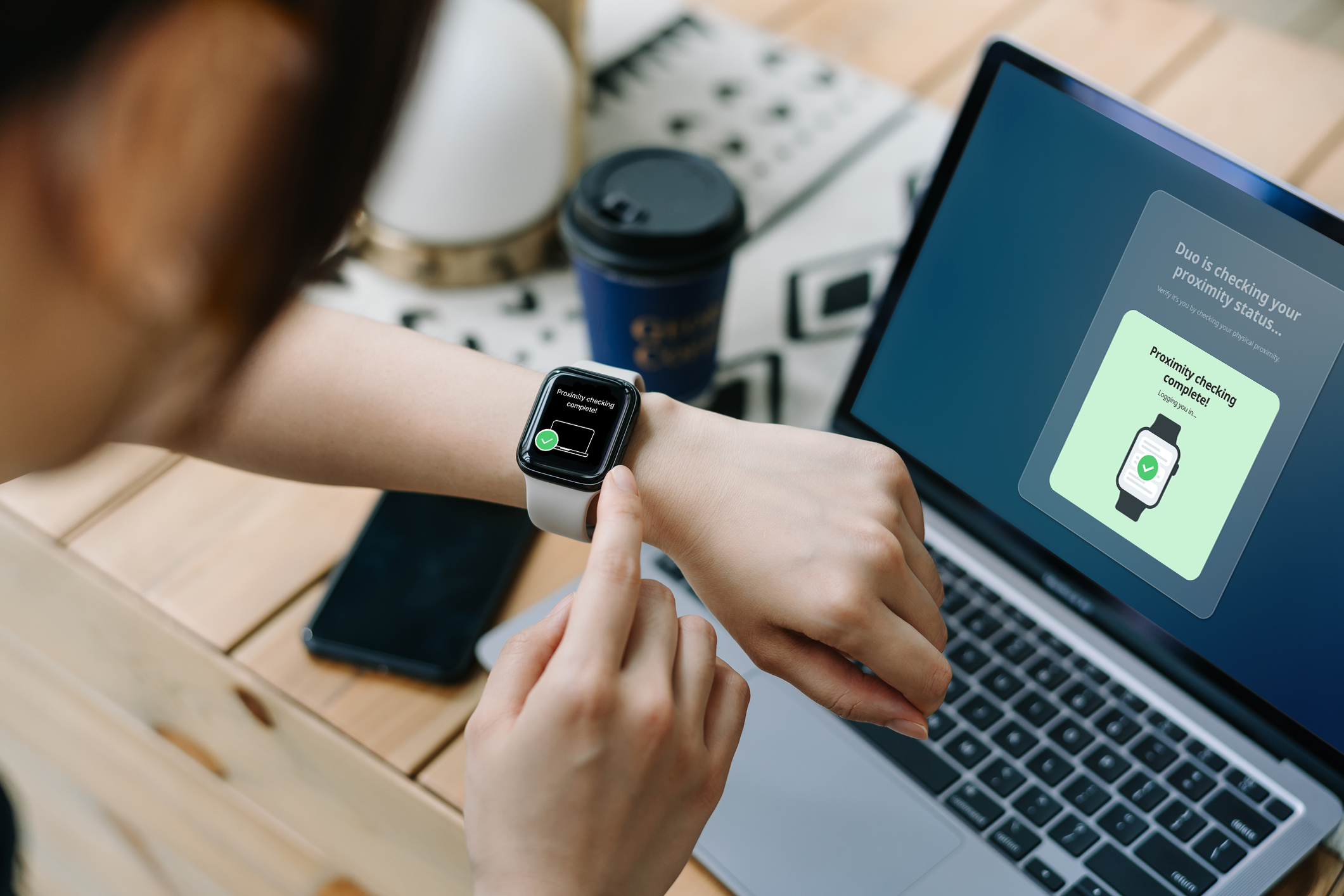
Cisco Duo Security
SaaS | Security Platform | 0-1 Product Design
Designed a user-centric zero-trust security platform for people with vision impairment.
PROJECT TYPE
End-to-end UX design project for
Cisco Duo Security
TARGET USER
Duo end users with vision impairment
DURATION
Sep 2022 - Dec 2022
TEAM
Collaborator: Phyllis Fei
Project manager: Melanie Girod
OUTCOME
• Client pitching & Demo day 2nd place
• Submitted research paper to The ACM CHI Conference
• Posted our work to the Cisco Blogs
MY CONTRIBUTION
UX research: competitive analysis, user interviews, and contextual inquiry
UX design: wireframing, mid to high-fidelity prototyping, and usability testing

BACKGROUND
Overview
As a selected member of the 'Equitable Design Lab' at UC Berkeley Haas Business School, I collaborated with Cisco, an industry sponsor, to address specific problem statements and develop day-in-the-life design solutions.
I focused on Cisco Duo Security, a two-factor authentication and data protection product to enhance organizations' cybersecurity resilience. Its user-friendly features encompass secure access, robust authentication, and device monitoring.
My role
As a UX designer, I led the project from 0 to 1, discovery to delivery, conducting thorough user research to validate design decisions and ensuring the creation of products that truly resonate with users. Key responsibilities included defining product strategy, analyzing user research, wireframing mid-fi prototypes, and designing high-fidelity deliverables.
DEFINE
Problem Statement
As cybersecurity concerns grow, particularly among the visually impaired, the reliance on visual interfaces in current cybersecurity products has posed a significant challenge. This dependence left visually impaired individuals more vulnerable to cyberattacks due to the lack of visual cues.
Cisco approached us to explore how cybersecurity can be made more accessible and inclusive for people with disabilities, particularly those with vision impairment. My focus narrowed to identifying accessible methods to detect, prevent, alert, or resolve cybersecurity attacks on this specific user group with vision impairment.

Alert cyber attacks to people with vision impairment in a faster yet less overwhelming way?
HOW MIGHT WE…
DESIGN PROCESS
RESEARCH
Research strategy
I structured our research into two phases:
The first phase consisted of secondary research, where I delved into the problem's context, conducted initial stakeholder interviews, and explored existing solutions.
This was followed by a Primary research phase, focusing on three interview criteria: individuals with disabilities, professionals in accessibility and disability research, and cybersecurity experts.
I conducted 11 in-depth user interviews and synthesized the data into an affinity map. This map informed the creation of personas, empathy maps, journey maps, and design concepts. Additionally, I identified stakeholders, conducted formative interviews, pinpointed user pain points, and analyzed technology-based solutions currently integrated into their daily lives.
Analysis
I synthesized the data collected from the interviews and competitive analysis into an affinity map to help form insights and brainstorm design ideas to solve users’ high-priority problems.

Key insights
After analyzing the affinity map, it's clear that individuals with low vision are adept at using digital devices and assistive tech but struggle with distinguishing notifications from different apps. They rely on distinct sounds and vibrations, which can be overwhelming for them and others nearby, especially when multiple alerts occur simultaneously.
This constant monitoring of alerts consumes a lot of energy, and while these technologies are helpful, they can also be interruptive. Users with low vision process sounds and vibrations more frequently than those without disabilities.
Key insights:
Reliance on distinct alerts is burdensome and overwhelming.
Constant monitoring of alerts consumes significant energy.
Assistive technologies, while helpful, can also be interruptive.
User persona & Empathy map
Based on my insight and observation from the research methods, I created a user persona that captured our users' essence and characteristics. I also formed empathy maps to understand their needs and frustrations.
Task analysis & Journey map
The persona and empathy map helped me outline a hierarchical task analysis, which I then used to make a journey map highlighting the pain points and the opportunities for improvement.
Brainstorm ideas
IDEATE

DESIGN
Given our research findings, I came up with two divergent potential solutions that tackled the problem spaces: overwhelming experience, voiceover usability, and eavesdropping and authentication usage.
Potential solutions
Stakeholder evaluation
I conducted interviews with key stakeholders for feedback and insights:
Interviewed TK Keanini, Cisco's CTO, our most significant indirect stakeholder, for feedback on research and potential solutions.
Spoke with Adam Goodman, a Principal Engineer at Cisco and our direct stakeholder, about ideas for the Duo authentication process and past designs.
Interviewed a visually impaired Duo user, our core stakeholder, to gauge interest in our design solutions.
After evaluation, the design that was of the most interest was the wearable, Safelet.
TEST

DELIVER
Solution
I introduced a novel authentication method, physical proximity, as an innovative approach outside traditional assistive technologies. This method simplifies authentication by automatically authenticating users based on their physical proximity without relying on haptic or sound feedback.
This improvement enhances safety, reduces reliance on voiceover, and streamlines the app-based 2FA product by pairing users' devices with proximity. Consequently, users can avoid the overwhelming experience of having every line in the Duo mobile app read aloud by voiceover and navigating through multiple browser tabs.
ITERATE
Iterate design

EVALUATION
I conducted a remote authentication usability test with 4 participants, including individuals with and without visual impairment. Following this, I conducted qualitative interviews, prompting participants to describe their thoughts while comparing experiences before and after the design prototype.
The evaluation process included:
Explaining the prototype concept to users.
Playing recorded auditory prototype videos of before and after experiences.
Explaining each step-by-step action on the screen.
Asking for feedback by comparing before and after experiences.
Inquiring about the appeal and safety of the new solution.
Analyzing testing findings to identify improvement opportunities within the data.
Based on these insights, I iterated on the designs to enhance usability and effectiveness.
Usability test
Feedback
The gathered feedback on the prototype was predominantly positive. Participants expressed gratitude for the new solution, indicating a favorable reception.
Subsequent interviews provided qualitative insights into users' thoughts on the new authentication method:
“I didn’t realize how complicated the current experience is until I tried your design prototype.
It is so much better.”
— Sangita, the core user with visual impairment
“As a person without vision impairment, I would even love to choose this auth method. It’s so fast and convenient! I wish this option could be available ASAP.”
— Pooja, direct stakeholder, the general user without a disability
“The ultimate goal of a design is that you start from one focus group and extend it to benefit all users. Proximity authentication is great.”
— Colin, indirect stakeholder, Cisco’s senior accessibility engineer
The metric tracked for our solution was the reduction in the time required for the authentication process.
Our solution impacted users by significantly speeding up and simplifying the login authentication. Users no longer needed to rely on assistive technologies or navigate between multiple browsers, making the process much quicker and easier.
This solution also directly benefited the company, positively impacting all Duo users. The streamlined authentication process saved substantial time for individuals with visual impairments and those without disabilities.
Impact
Educate users
I will design a revamped onboarding process. Additionally, I will create a practice demo video that provides a hands-on demonstration of how the new method works.
Next steps
Implement technology
I will collaborate with Cisco to determine the required backend technology. Developers could explore various options in the backend network architecture for this proposed solution. However, the user experience in the front end will remain consistent regardless of the chosen backend architecture.
Origin story
I learned that product insights can come from anywhere through data-driven research, identifying problems to solve for a better user experience.
User story
By self-objectifying in the design process, I avoided the mistake of assuming "I am the user." Instead, I engaged directly with users to discover their real needs.
Industry story
I was impressed by the wide impact of my design solution, which benefits both visually impaired individuals and those without disabilities.





























